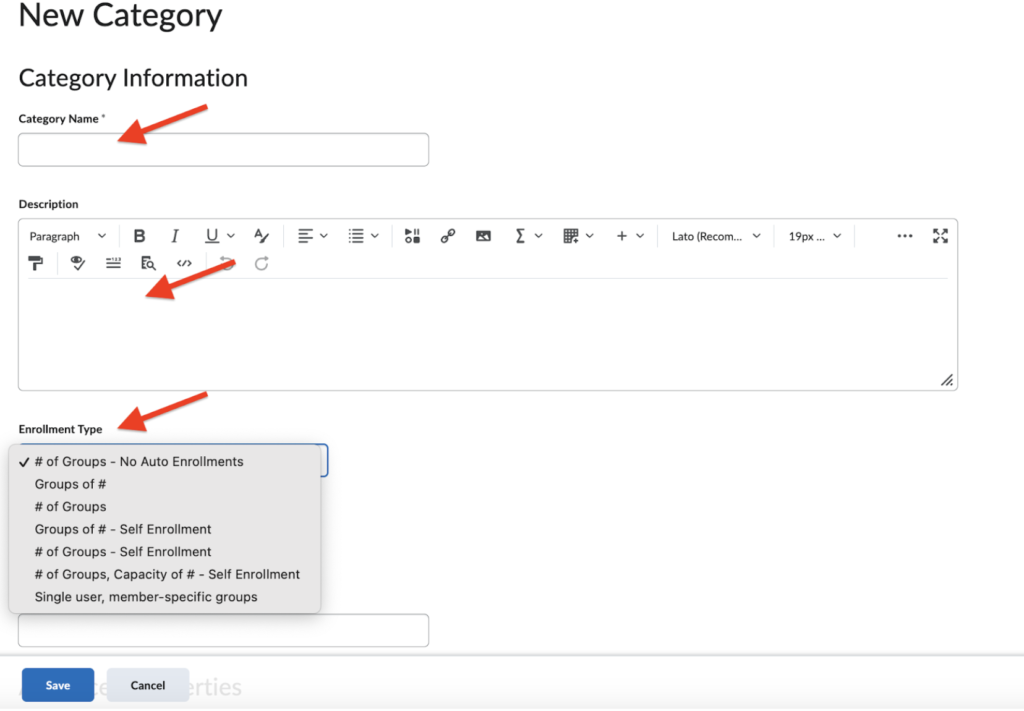
Quick Path:
Nav bar > Tools > Groups > Manage Groups > New Category > [Customize Settings] > Save
Introduction
Groups in Brightspace are a powerful way to manage collaborative activities, such as group projects, discussions, or assignments. This guide provides step-by-step instructions on how to create groups in Brightspace.
In Brightspace, groups are set up within categories. For example, you might have a category called “Final Project,” and within that category, you can create five groups, each of which will work together toward a final group project.
Attention: Students who officially withdraw (W) will still appear in group enrollments. Make sure to check the Groups Enrollment list against your Classlist when enrolling students in Groups.
Steps for Creating Groups
- On the course navigation bar, click ‘Tools’ and select ‘Groups’ from the dropdown menu.
- On the Manage Groups page, create new groups [category] by clicking the New Category button.
What is a category? If students stay in the same group throughout the course, you will have only one category. You can give it a name related to the group activity, such as Final Project, Case Study, Clinical Group, Project Team, Research Group, etc. If students are assigned to different groups during the course, then you will create a new category for each group.
- Enter the category details such as the name, and description (including any instructions on group enrollment), and select the enrollment type (automatic, instructor-specified, or self-enrollment).

Enrollment Types with Descriptions:
- # of Groups – No Auto Enrollments: The instructor sets the number of groups and manually assigns students to each group
Note: We recommend this as the least complicated option. - Groups of # – Auto Enrollment: set the group capacity
- # of Groups – Auto Enrollment: set the total number of groups
Note: If groups are set for auto-enrollment, it is important to review Group enrollments against the Classlist to ensure withdrawn (W) students are not appearing in groups. Officially Withdrawn (W) students will not appear in the Classlist but may appear in groups. - Groups of # – Self Enrollment: set the group capacity and students will be able to self-enroll in groups
- # of Groups – Self-Enrollment: set the total number of groups and students will be able to self-enroll
- # of Groups, Capacity of # – Self Enrollment: set both the number of groups and group capacity and students will be able to self-enroll
- Single user, member-specific groups: set up groups of 1
Note: this option is useful for student journals
For more detailed information about enrollment types, please refer to Creating categories and groups (D2L Community).
Please note, based on the Enrollment Type you selected, you’ll need to complete fields related to the number of groups, number of users per group, and other relevant enrollment options.
If you choose the Groups of # or # of Groups enrollment types, you will have three additional options under Advanced Properties. Select those group options based on your needs.
- Auto-enroll new users: If enabled, this option automatically assigns any new students who join the course later to a group within this category.
- Randomize users in groups: students will be enrolled into groups in a random order. If disabled, students will be placed into groups according to their order in the classlist.
- Make category and group descriptions visible to group members.
Set up Group Workspaces
- Under Additional Options, select which one(s) you would like to incorporate:
- Set up Discussion areas: Enabling this option will create a discussion item that is accessible only to group members. The instructor will also be able to view and participate in the discussion.
- Set up lockers: A Group Locker gives your students the possibility to quickly and easily share files.
- Set up assignment submission folders: Selecting this option allows you to create an Assignment immediately, which will be linked to these groups and enable group submissions. If you have already created the assignment, or if you prefer to create a group assignment at a later time, you can skip this step and instead follow these instructions to set up group submissions for a Brightspace assignment.
- After settings are complete, click ‘Save’. Brightspace will take you to the assignment setup page automatically.
Still have questions? Email us at FacultySupport@sps.cuny.edu. We’re here to help!
Was this helpful?
0 / 0
[…] you haven’t created groups in Brightspace yet, please refer to this guide on how to create groups. This guide assumes that groups have already been created, and describes […]
[…] you haven’t created groups in Brightspace yet, please refer to this guide on how to create groups. This guide assumes that groups have already been created, and describes […]